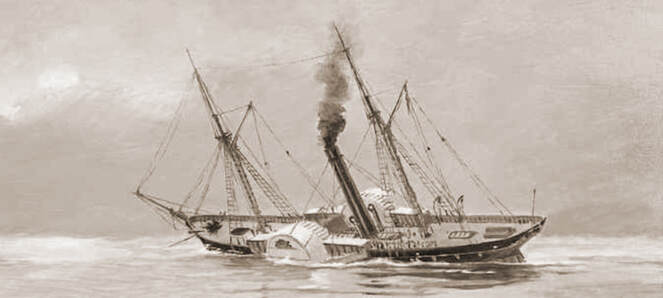Early Steamship Clonmel Lost In Exploring Australian Shores
By James Donahue
The new steamship Clonmel, the pride of the Australian colony, was wrecked in 1841 on a sandbar at the entrance to Port Phillip, a natural harbor that was later going to be known as the City of Port Albert.
It was the Clonmel’s second voyage from Sydney to Port Phillip. The sidewheel steamship was imported to Australia as a new venture in shipping by investor Edye Manning only months before it wrecked. It was supposed to provide a faster and improved shipping service between Sydney and Melbourne. Instead, the Clonmel held the distinction of being the first steamer to work the Eastern Australian coast, and the first to wreck there.
The 600-ton luxury vessel, under the command of Captain Tollervey, went hard aground on the bar on the afternoon of January 2 and never floated again. On board were a number of influential people from Sydney and valuable cargo. That cargo included a 3000-pound shipment of bank notes for the Union Bank’s Melbourne branch.
After an anxious night, the passengers and crew were safely landed on a small island that now is named after the ship.
Shifting sands buried the wreck until 1984 when portions of the ship were found to be visible at low tide. Within the next 11 years movements of the sand exposed more of the vessel allowing maritime archaeologists from Heritage Victoria to recover valuable items and cargo.
Those items are on exhibition at the Port Albert Maritime Museum.
By James Donahue
The new steamship Clonmel, the pride of the Australian colony, was wrecked in 1841 on a sandbar at the entrance to Port Phillip, a natural harbor that was later going to be known as the City of Port Albert.
It was the Clonmel’s second voyage from Sydney to Port Phillip. The sidewheel steamship was imported to Australia as a new venture in shipping by investor Edye Manning only months before it wrecked. It was supposed to provide a faster and improved shipping service between Sydney and Melbourne. Instead, the Clonmel held the distinction of being the first steamer to work the Eastern Australian coast, and the first to wreck there.
The 600-ton luxury vessel, under the command of Captain Tollervey, went hard aground on the bar on the afternoon of January 2 and never floated again. On board were a number of influential people from Sydney and valuable cargo. That cargo included a 3000-pound shipment of bank notes for the Union Bank’s Melbourne branch.
After an anxious night, the passengers and crew were safely landed on a small island that now is named after the ship.
Shifting sands buried the wreck until 1984 when portions of the ship were found to be visible at low tide. Within the next 11 years movements of the sand exposed more of the vessel allowing maritime archaeologists from Heritage Victoria to recover valuable items and cargo.
Those items are on exhibition at the Port Albert Maritime Museum.
